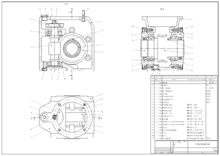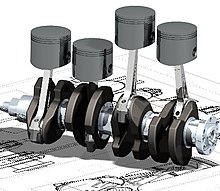
Back Rekenaargesteunde ontwerp Afrikaans تصميم بمساعدة حاسوب Arabic Avtomatlaşdırılmış layihələndirmə sistemləri Azerbaijani Компютърно проектиране Bulgarian কম্পিউটার-এইডেড ডিজাইন Bengali/Bangla CAD BS Disseny assistit per ordinador Catalan Computer aided design Czech Computerstøttet design Danish CAD German


Computer-aided design (CAD) is the use of computers (or workstations) to aid in the creation, modification, analysis, or optimization of a design.[1]: 3 This software is used to increase the productivity of the designer, improve the quality of design, improve communications through documentation, and to create a database for manufacturing.[1]: 4 Designs made through CAD software help protect products and inventions when used in patent applications. CAD output is often in the form of electronic files for print, machining, or other manufacturing operations. The terms computer-aided drafting (CAD) and computer-aided design and drafting (CADD) are also used.[2]
Its use in designing electronic systems is known as electronic design automation (EDA). In mechanical design it is known as mechanical design automation (MDA), which includes the process of creating a technical drawing with the use of computer software.[3]
CAD software for mechanical design uses either vector-based graphics to depict the objects of traditional drafting, or may also produce raster graphics showing the overall appearance of designed objects. However, it involves more than just shapes. As in the manual drafting of technical and engineering drawings, the output of CAD must convey information, such as materials, processes, dimensions, and tolerances, according to application-specific conventions.
CAD may be used to design curves and figures in two-dimensional (2D) space; or curves, surfaces, and solids in three-dimensional (3D) space.[4][5]: 71, 106
CAD is an important industrial art extensively used in many applications, including automotive, shipbuilding, and aerospace industries, industrial and architectural design (building information modeling), prosthetics, and many more. CAD is also widely used to produce computer animation for special effects in movies, advertising and technical manuals, often called DCC digital content creation. The modern ubiquity and power of computers means that even perfume bottles and shampoo dispensers are designed using techniques unheard of by engineers of the 1960s. Because of its enormous economic importance, CAD has been a major driving force for research in computational geometry, computer graphics (both hardware and software), and discrete differential geometry.[6]
The design of geometric models for object shapes, in particular, is occasionally called computer-aided geometric design (CAGD).[7]
- ^ a b Narayan, K. Lalit (2008). Computer Aided Design and Manufacturing. New Delhi: Prentice Hall of India. ISBN 978-8120333420.
- ^ Duggal, Vijay (2000). Cadd Primer: A General Guide to Computer Aided Design and Drafting-Cadd, CAD. Mailmax Pub. ISBN 978-0962916595.
- ^ Madsen, David A. (2012). Engineering Drawing & Design. Clifton Park, New York: Delmar. p. 10. ISBN 978-1111309572.
- ^ Farin, Gerald; Hoschek, Josef; Kim, Myung-Soo (2002). Handbook of computer aided geometric design [electronic resource]. Elsevier. ISBN 978-0-444-51104-1.
- ^ Cite error: The named reference
Schoonmaker2003was invoked but never defined (see the help page). - ^ Pottmann, H.; Brell-Cokcan, S. and Wallner, J. (2007) "Discrete surfaces for architectural design" Archived 2009-08-12 at the Wayback Machine, pp. 213–234 in Curve and Surface Design, Patrick Chenin, Tom Lyche and Larry L. Schumaker (eds.), Nashboro Press, ISBN 978-0-9728482-7-5.
- ^ Farin, Gerald (2002) Curves and Surfaces for CAGD: A Practical Guide, Morgan-Kaufmann, ISBN 1-55860-737-4.
© MMXXIII Rich X Search. We shall prevail. All rights reserved. Rich X Search